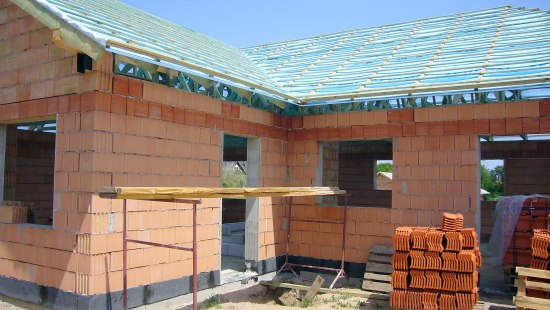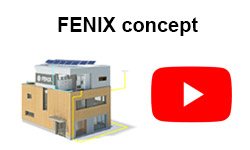Electric heating in an energy-saving detached house – part II

The construction of an energy-saving house with an electric floor and ceiling heating system
The calculations in the first part of the series of articles about the construction of an energy-saving house in Moravany u Brna confirmed that this design with its electric heating system will be very economical; the project author also appreciated the variability of the heating system, the accuracy of regulation and the high user comfort. Thermal comfort throughout the house will thus be provided by FENIX Jeseník products - for the REP-HOUSE, floor heating via ECOFILM foils was chosen for most areas, and ECOFLOOR heating mats were fitted under the floor tiling in the bathrooms and kitchen. In two rooms, the author designed ceiling heating using ECOFILM C foils. Of course, this is all with BMR central regulation.
A standard warm-water heating system was ruled out and an alternative chosen: floor heating in the form of ECOFILM electric heating foils, ECOFLOOR electric heating mats under floor tiling and also ECOFILM C ceiling foils under the plasterboard ceiling. The author of the project installed ECOFILM floor heating foils in the study, bedroom, children’s room, living room, dining room, dressing rooms and corridor, where the surface layer will be formed by floating laminate floors. Heating foils are also an ideal direct-heating system for the REP-HOUSE as they provide an even distribution of heat across their whole surface. The operational temperature of the heating foil will be, in comparison with other heating media (e.g. water, oil) very easy to regulate, which means that it is possible to set the timing of required comfort or attenuation temperatures in a very flexible and, most importantly, accurate manner. The accuracy of regulation is one of the main factors in the creation of a stable and comfortable environment, and in the lowering of heating costs.
In two of the residential rooms, ECOFILM C heating foil is placed under the plasterboard ceiling. The concealed installation doesn’t interfere with the appearance of the room in any way, and the temperature is very easy to regulate despite the placement of the heating in the ceiling. In addition, the air won’t dry up and increased dust circulation, which is typical for standard convection systems, won’t occur. The width of the ECOFILM foils corresponded exactly with the recommended spacing of the load-bearing elements of the plasterboard structures and it was possible to install them directly onto these elements without the necessity of other alterations to the structure.
In the utility room, the bathroom with WC, and in the kitchen and larder, ceramic floor tiling will be used as the surface layer and therefore the author used ECOFLOOR electric heating mats for heating, as they are more suitable for this type of floor and also feature a very attractive price.
Regulation is important
An important factor, particularly in the case of electric heating, is regulation. It has a very important influence not only on operating costs but also on heating comfort throughout the whole building. Therefore, the investor chose central regulation from a Czech producer – BMR, a company based in Rychnov nad Kněžnou. The regulation controls the heating in the individual rooms via semi-conductor switching, which is contact-free. Compared to the switching contacts of standard thermostats, it is absolutely silent (it doesn’t click), it doesn’t have a limited number of switching cycles (a significantly longer lifespan) and so is also ideal for what is termed pulse width modulation. This term describes a function in which the heating regulation switches on and off in alternation. As the monitored room approaches the required value, the heating cycles shorten smoothly. The room is thus heated exactly to the required temperature and that temperature isn’t exceeded (overheating) – which will obviously have a positive result in terms of operating costs.
The regulation not only enables the setting of a week-long programme with an individual temperature mode for each room in the building, but also allows as-needed changes to the temperature in the room by the user, convenient control of regulation via a computer and the internet and the recording of temperatures and hours of operation in each room. Practical experience with previous installations has shown that the use of this central regulation achieves up to 30% savings in operating costs in contrast with the use of individual thermostats in each room.
Low-temperature sources are sufficient for heating
Thanks to the low heat loss of the house (only 3kW), it was possible to use a low-temperature source with a heating foil performance of 60W/m2 and a surface temperature of 25°C. The low heat loss of the house will allow the heating of this family home with electrical energy more cheaply than e.g. by natural gas – this is mainly thanks to the advantageous electrical energy tariff which makes electricity a cheap power source for all electric appliances in the house (kitchen equipment, washing machine, house lighting, all electronic devices and other items). Cheaper heating using electricity (in comparison with gas) is characteristic not only of passive houses but also of low-energy family homes (LEH).
This is also confirmed by real experience from other reference low-energy buildings, details of which are now available to Fenix Jeseník. In similar projects to the REP-HOUSE in Moravany u Brna, the consumption of "domestic" energy exceeds the consumption for the heating of the building and thus evens out (including the monthly fees) the possible difference in comparison with gas.
The ECOFILM floor foil is placed directly under the floor and thus the main part of the heat goes straight into the room. Despite this, during days when the heating is used part of the heat accumulates in the base concrete which is well insulated thermally from the bottom side – from the soil. The building thus gains thermal stability for several more days even when heating is interrupted, which enables heavy use to be made of the low tariff. The outside walls also ensure good thermal stability - thanks to quality thermal insulation on their outer sides they can maintain room temperature not only on their interior surfaces but also throughout their whole thickness.
Economic efficiency – yearly heating costs under 7,000 CZK
The cost of constructing the REP-HOUSE doesn’t differ much in comparison with its neighbouring house, which has standard thermal properties, and the acquisition costs were only approx. 9% higher. However, the utility properties of the building are very high, particularly from the point of view of the internal microclimate – i.e. temperature and air humidity. The construction of the building’s structure and the selected heating system prevent the occurrence of discomfort caused by increased air circulation or possible water vapour condensation and mold growth on internal structures.
The heating energy consumption of the REP-HOUSE project is expected to be 14 kWh.m-2.a-1, while the total energy requirement is 95 kWh.m-2.a-1 (including warm-water heating, ventilation and other items). The cost of heating should range between 6 – 7 thousand CZK with the present energy prices. 60% of the energy used in the heating of warm water (mainly in the summer season) should be covered by solar collectors, for which the investment return is expected to occur in approximately 10 years. Generally, the author estimates the return on the higher investment into the construction of the energy-saving house to occur in six years, assuming a five-percent increase in the price of energy per year.
You can find the first part of the trilogy here…
You can find the third part of the trilogy here…









